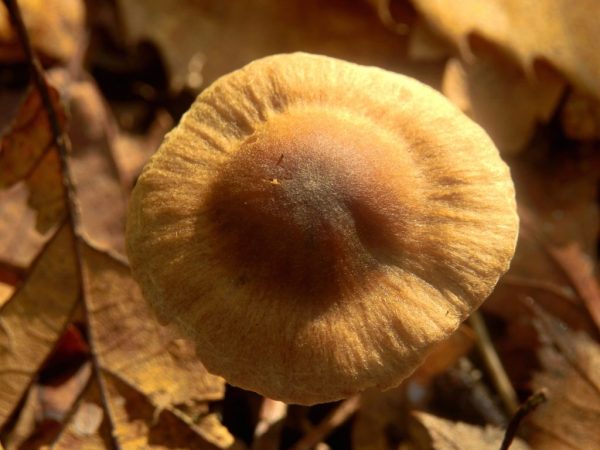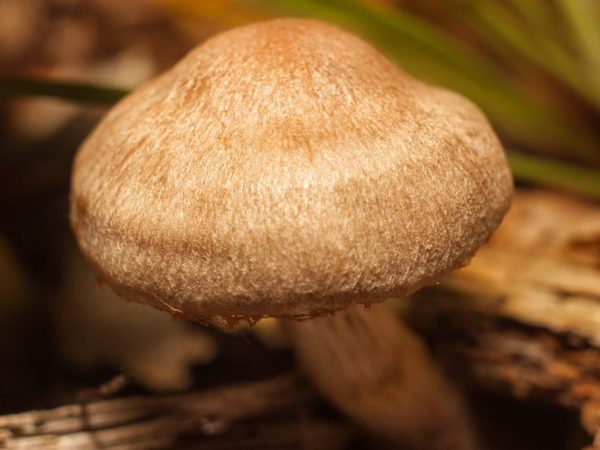Fiber mushroom and its varieties
The fibrous mushroom is an inedible representative of the Gossamer family, or Cortinaria. It is an agaricomycete. It got its name due to the special - fibrous structure of the mushroom leg.

Fiber mushroom and its varieties
General botanical characteristics
Mushrooms belonging to the genus Fibers have cap-pectus fruiting bodies. The shape of the mushroom cap is conical or bell-shaped. In the central part, there is often a tubercle in age fungi. The surface structure is fibrous, silky, in some specimens covered with scales, sometimes radially cracked.
Many species are characterized by the presence in the chemical composition of a large amount of the alkaloid muscarine, and they also have a hallucinogenic effect due to the chemical composition of the alkaloid psilocybin.
The mushroom leg is silky in structure, often covered with scales. The color is pale brown or brown.
The genus Volokonnitsa unites about 150 species growing in forests on soil and among grass plantings. There are about 100 species growing in Russia. The most famous:
- in. earthen;
- in. Patuillara;
- in. sharp;
- in. whitening;
- in. blushing;
- in. blue.
Irina Selyutina (Biologist):
Fibers often have a specific unpleasant or fruity aroma. They grow on soil in forests, some of the species are mycorrhizal formers. Among them there are deadly poisonous mushrooms. Signs of poisoning may appear after 1.5-2 hours. In this case, the following symptoms are noted:
- profuse salivation and sweating;
- chills;
- convulsions;
- weakening of vision.
In especially severe cases, due to a drop in cardiac activity, death may occur or a person falls into a prolonged unconsciousness. Respiratory distress is also common. Recovery or death from fiber toxins occurs on the second day.
Fibers can be an example:
- forest litter saprophytes, for example, Inocybe obscura, which grows mainly in coniferous forests, etc .;
- humus saprophytes growing on soil: most species of the genus.
Earthen fiber
Earthen fiber is a poisonous representative of the genus; muscarine is present in the chemical composition.
The mushroom cap grows up to 1-3 cm in diameter. The shape is initially conical, then outstretched. When ripe, a tubercle forms in the central part. The surface is silky, the structure is fibrous. The color is initially white, after a while it becomes light pink or light purple, sometimes yellowish. Cracking edges.
The geography of distribution of earthen fiber covers the European part of Russia, the Caucasus and the Far East. Found in the North American and North African regions, East Asia and Western Europe.
The mushroom leg grows 2-5 cm long, 0.2-0.5 cm thick. The structure is dense in young specimens, and hollow in adults. Straight in shape, without characteristic thickenings at the base, longitudinally fibrous.The upper part is covered with a mealy bloom. The color is closer to white, eventually darkens to brown.
The mushroom pulp is thin and fragile, has a faint earthy odor and an unpleasant aftertaste.
Grows singly or in groups in woodlands of various types, mainly deciduous. Often seen at road edges. Able to form mycorrhiza with pine roots.
Fiber is sharp
Sharp fiber - a poisonous mushroom with a cap measuring 1-3.5 cm in diameter, bell-shaped, eventually acquiring a flat-convex shape with a clearly prominent central tubercle. Typical brown shades.
Acute fibrillus is widespread mainly in Europe, it is found in the territory of Eastern Siberia. Grows in wetlands, sometimes on peat mosses.
The mushroom leg is 2-4 cm long and 0.2-0.5 cm thick, in the shape of a cylinder. The color is similar to the color of the cap. Its upper part is covered with bloom.
The color of the pulp is closer to white; when it comes into contact with air, the shade does not change.
Fiber Patuillard

Fiber mushroom is deadly
Fiber Patuillard is a deadly representative of spiderwebs. The mushroom cap has a white or gray color, in mature specimens it becomes reddish or red-brick. Diameter - 3-9 cm. The shape is initially in the form of a cone, then it becomes flat, but a tubercle remains in the central part. The surface is smooth and has a silky sheen. The edges are covered with radial cracks. The brightly colored fruiting body makes it extremely attractive for young children in the case of its growth within the boundaries of the settlement.
The amount of muscarine contained in the Patuillard fiber box is 20-25 times higher than the share of the poisonous substance in the red fly agaric.
This species grows in park and garden areas, deciduous, mixed and coniferous forests. Prefers limestone and clay soil. Able to form mycorrhiza with beech and linden roots.
Irina Selyutina (Biologist):
Fiber Patuillard is strictly confined to neutral and alkaline soils. This property of the fungus is so permanent that it can be used as an indicator of soil health.
Mushroom pulp without a characteristic odor, has a peppery aftertaste, white in color. Under mechanical action, it acquires a red color, especially in overripe mushrooms.
The geography of distribution of the Patuillard fiber covers separate regions of Asia and Europe. She is often met in the Caucasus.
The mushroom leg is 4-10 cm long, 0.8-1.5 cm thick. The color is similar to the color of the cap or lighter. The structure is dense. The shape is cylindrical, even, or thickens towards the base - forms a tuberous swelling. The fungus has a fibrous stem surface and grooves located on it.
Reddening fiber
The blushing fiber is one of the deadly poisonous representatives of the genus.
Its cap grows up to 6-9 cm in diameter. Like most representatives of this systematic group, the shape of the cap is initially bell-shaped, then straightens out, keeping a tubercle in the center. The color of the mushroom cap in young specimens is whitish, eventually changing to reddish or yellowish.
A lethal dose of fresh reddening fiber is 10-80 g.
The mushroom pulp has an alcoholic smell and an unpleasant aftertaste. The mushroom leg is up to 7 cm long, 0.5-1 cm thick. Its structure is dense. The color is similar to the color of the cap.
Preferred growth sites are coniferous and deciduous forests.
Whitening fiber
Whitening fiber is a poisonous representative of the genus. The diameter of the mushroom cap is 1.5-6 cm. It can be convex or conical, but with the obligatory presence of a whitish tubercle in the center.
The mushroom leg is 3-10 cm long and 0.4-0.7 cm thick, has the shape of a cylinder. It is solid in structure. The color is usually whitish pink. The upper part is covered with a mealy bloom.
Whitening fiber is a rare species. The geography of distribution covers the territory of Kazakhstan.
Mushroom pulp is closer to white in color. It is fragile in structure, has a mild taste and a pleasant smell.
Grows in large groups in pine forests on coniferous litters.
Fiber blue
Fiber Blue, or blue-green - refers to those representatives of the Spiderweb family, which are characterized by the presence of a hallucinogenic effect due to the chemical composition of psilocybin. The mushroom is conditionally edible after prolonged boiling.
Mushroom cap 1-4.5 cm in diameter. The shape of the cap in young mushrooms is classic bell-shaped, subsequently prostrate. The edges are sinuous, cracking. The surface is silky, smooth in the central part, fibrous closer to the edges, covered with scales.
The geography of distribution of the blue-green variety covers the European temperate zone.
The mushroom pulp has a strong perfumed soapy smell. The mushroom leg is 2.5-7 cm long, 0.3-0.7 cm thick. The lower part has a blue-green tint, but there is no nodule-like thickening.
The blue variety grows on wet sandstones, is capable of forming mycorrhiza with the roots of poplar, linden, aspen, birch, oak. Also found in parks and gardens.
Conclusion
Representatives of the genus Fiber in most cases are inedible or poisonous. For poisonous representatives of the genus, the content in the chemical composition of muscarine and psilocybin was determined.



